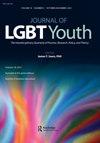来自八个欧洲国家和地区的15岁青少年的浪漫爱情和参与欺凌和网络欺凌
IF 1.8
Q1 SOCIAL SCIENCES, INTERDISCIPLINARY
引用次数: 1
摘要
性少数群体青少年遭受欺凌的风险高于异性恋同龄人,但有关欺凌行为和网络欺凌的数据有限。本研究使用来自7个欧洲国家和1个地区的代表性数据(N = 14,545),比较了15岁的报告曾经与同性或双性恋的同龄人(性少数)和异性同龄人(非少数)恋爱的青少年的传统欺凌受害和犯罪行为,以及网络欺凌受害情况。从未恋爱过的青少年和未被调查者也包括在内。分析按性别分层,并根据国家/地区和家庭富裕程度进行调整。与被异性同伴吸引的女孩相比,双性恋女孩更容易报告传统的欺凌行为,而双性恋女孩和异性恋和同性恋男孩更容易报告欺凌受害者。与非少数群体的同龄人相比,所有性少数群体的青少年都更有可能报告网络受害者。与其他青少年相比,从未恋爱过的青少年受欺凌的程度较低。性少数群体的污名可能会增加青少年参与欺凌的风险。干预措施需要具体处理性少数群体青年的欺凌行为和相关的健康风险。现有证据表明,根据当地情况量身定制的明确的学校政策和干预措施特别有效。本文章由计算机程序翻译,如有差异,请以英文原文为准。
Romantic love and involvement in bullying and cyberbullying in 15-year-old adolescents from eight European countries and regions
Abstract Sexual minority youth are at greater risk for bullying victimization than their heterosexual peers but data on perpetration and cybervictimization is limited. Using representative data from seven European countries and one region (N = 14,545), this study compared traditional bullying victimization and perpetration, and cyberbullying victimization among 15-year-old adolescents who reported ever being in love with same- or both- gender peers (sexual minority) versus opposite-gender peers (non-minority). Adolescents who have never been in love and non-respondents were also included. Analyses were stratified by gender and adjusted for country/region and family affluence. Compared to those attracted to opposite-gender peers, traditional bullying perpetration was more likely to be reported by both-gender attracted girls, while bullying victimization was more likely to be reported by both-gender attracted girls and both- and same-gender attracted boys. All sexual minority youth were more likely to report cybervictimization compared to their non-minority peers. Adolescents who have never been in love reported lower levels of bullying involvement than all other youth. Sexual minority stigma may contribute to higher risk of bullying involvement among adolescents. Interventions need to specifically address bullying involvement and associated health risks of sexual minority youth. Available evidence shows that explicit school policies and interventions tailored to local settings are particularly effective.
求助全文
通过发布文献求助,成功后即可免费获取论文全文。
去求助
来源期刊

Journal of LGBT Youth
SOCIAL SCIENCES, INTERDISCIPLINARY-
CiteScore
5.40
自引率
8.30%
发文量
30
期刊介绍:
The Journal of LGBT Youth is the interdisciplinary forum dedicated to improving the quality of life for lesbian, gay, bisexual, transgender, and questioning youth. This quarterly journal presents peer-reviewed scholarly articles, practitioner-based essays, policy analyses, and revealing narratives from young people. This invaluable resource is committed to advancing knowledge about, and support of, LGBT youth. The wide-ranging topics include formal and non-formal education; family; peer culture; the media, arts, and entertainment industry; religious institutions and youth organizations; health care; and the workplace.
 求助内容:
求助内容: 应助结果提醒方式:
应助结果提醒方式:


